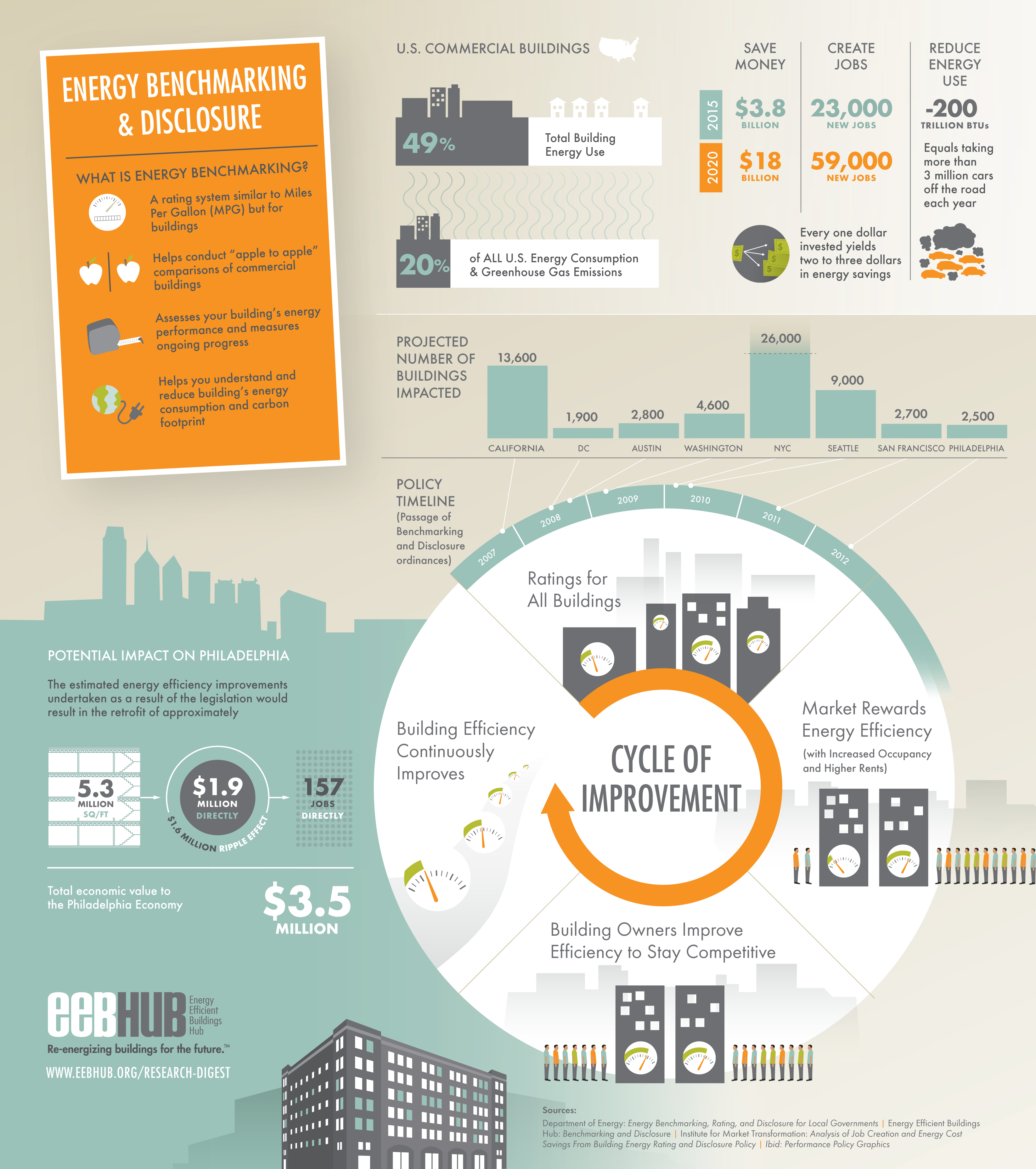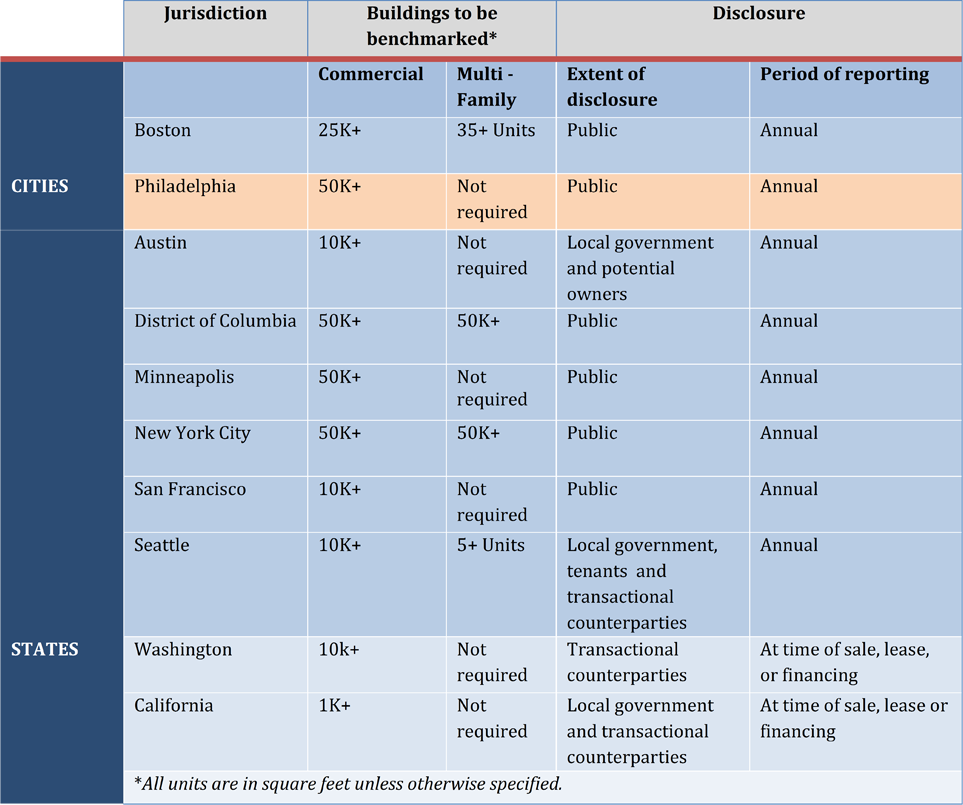Helping Buyers and Tenants Understand the Energy Efficiency of Buildings
Policy effort led by Laurie Actman, Deputy Director of the Energy Efficient Buildings Hub
Introduction

Commercial spaces account for almost half of total building energy. While many Americans know how energy efficient their vehicles are, few are aware of how energy efficient, or inefficient, their buildings are. Thus far, a lack of readily available, standardized information has hindered efforts to incorporate energy efficiency data into the market value of commercial property.
But, to make energy consumption more visible to potential buyers and tenants, governments are beginning to legislate energy benchmarking and disclosure. Philadelphia now joins cities such as Washington, D.C., San Francisco, and New York on the list of metropolitan areas that have adopted strategies to make energy efficiency a major factor in the calculus of building valuation.
What is Benchmarking and Disclosure?
Benchmarking refers to the process of measuring and comparing performance metrics [1]. In the building industry, energy benchmarking programs create standardized metrics to measure and compare energy efficiency between similar buildings, just as miler-per-gallon is used to compare energy efficiency between cars. Benchmarking allows owners to assess their building’s energy use and to gauge their building’s performance against others in the marketplace. Disclosure of this benchmarking data refers to the voluntary or mandatory release of this data to government, industry, or the public. Mandatory collection and disclosure of benchmarking data gives potential buyers or tenants the information they need to include a building’s energy efficiency in their decision to buy or rent. Thus far, over fifty national, regional, and local governments have passed ordinances mandating benchmarking and disclosure to some degree [2]. The potential impact of a national building energy rating and disclosure policy, according to a report from the Institute for Market Transformation and the Political Economy Research Institute, would be an energy savings for U.S. building owners totaling 0.2 quadrillion BTUs, or approximately $18 billion, by 2020.
History of Benchmarking Legislation
Denmark became the first country to introduce benchmarking legislation when, in 1997, the national government passed a law requiring energy certification for homes and buildings. Between 2002 and 2010, Norway, Brazil, China, Turkey, and the European Parliament followed suit, mandating some form of energy certification for buildings and homes. In 2007, California introduced the first policy aimed at energy efficiency to the United States, requiring commercial rating and disclosure during every sale, lease, or financing transaction. Since then, the state of Washington (2009) and seven major cities (Washington, D.C., 2008; Austin, 2008; New York City, 2009; Seattle, 2010; San Francisco, 2011; Philadelphia, 2012; and Minneapolis, 2013) have implemented benchmarking and disclosure legislation. See Table 1 for further information on individual city and state legislation.
Benchmarking in Philadelphia
On June 21, 2012, the Philadelphia City Council passed Bill 120428-A requiring owners of non-residential spaces of 50,000 square feet or more to track energy and water use and publicly disclose that data. Beginning in June of 2013, owners will be required to annually submit this information to the Mayor’s Office of Sustainability, which will compile and analyze the data and make it publicly available.

Owners will compile and submit their energy and water use data via the U.S. Environmental Protection Agency’s Portfolio Manager program, which has become the standard for benchmarking across the nation. This tool tracks energy and water consumption as well as building characteristics (such as age, type of use(s), operating hours, and potentially use-specific information such as the amount of area heated and air conditioned) to create an aggregate energy score on a scale of 1-100 for each building, with 75 being the threshold for Energy Star certification [3].
Several large buildings, such as the Comcast Center, already meet the Leadership in Energy & Environmental Design (LEED) or Energy Star certification standards. The combined floor space of these eco-labeled buildings in Philadelphia amounts to almost 20% of total commercial stock, well above the national average of 2.3%. However, the absolute number of buildings meeting these certifications is less than 5%: only 403 out of the 9,500 commercial properties in the region have received one of these eco-labels. A report released by the Econsult Corporation confirms the potential for further energy savings; it estimates that approximately 80% of Philadelphia’s commercial space is suitable for retrofit [4]. The EEB Hub expects that, as public data on the energy and water efficiency of offices and buildings becomes more readily available, companies will have new opportunities to assess their energy consumption and take steps to reduce it.
New York City Case Study
As part of the city’s Greener Greater Plan, New York City passed in 2009 Local Law 84 (LL84) requiring individual properties over 50,000 square feet or multiple buildings with a combined square footage over 100,000 sq. ft. to measure and report energy and water use [5]. The law covers 12,600 private sector lots, totaling 2.6 billion sq. ft. The threshold for public disclosure of benchmark data is much lower for city government properties; all city government buildings with 10,000 square feet or more are now required to track water and energy use and provide the public with access to the benchmark data. Ultimately, individual building data – including the Energy Performance score, greenhouse gas emissions (GHG), water use per square foot, site Energy Use Intensity (EUI) (kBtu per sq ft per year) and weather-normalized EUI (which tracks EUI over time to normalize for annual weather variation) – will be available to the public.
A report issued after the first year of LL84 indicates that the potential for energy savings are significant. The most energy intensive buildings use three to five times the amount of energy of the least energy intensive buildings (in the retail sector, the disparity is even more dramatic at a factor of 8), which suggests that even moderate improvements to the worst-performing buildings could result in significant citywide energy savings. For example, bringing large buildings up to the median (50th percentile) energy use standard would reduce citywide energy consumption in large buildings by approximately 18%; bringing them to the 75th percentile would reduce citywide energy consumption by 31%.
The report shows a correlation between performance and fuel sources. In multi-family properties, the worst 10% of performers tend to rely on electricity (e.g., electric heat and hot water), while the best 10% generally use natural gas and rely less on “dirty fuels” (number 2 and 5 fuel oils). Similarly, office buildings with lower EUIs rely more on district steam and those with higher EUIs rely more on “dirty fuels.” The report also found that older office buildings tend to use less energy per square foot than newer ones, largely because of less extensive ventilation systems and better-insulated envelopes.
Job Creation
The need for accurate building energy data has increased demand for professionals who have the training to collect and verify it, such as building managers who organize and deliver consumption data and engineers who can perform audits to verify the self-reported data and ensure compliance. A report from the Institute for Market Transformation (IMT) and the Political Economy Research Institute estimated that benchmarking and public disclosure laws could lead to the creation of over 23,000 new jobs by 2015 and over 59,000 jobs by 2020 nationwide. Estimated impacts of this legislation for Philadelphia include between 2,630-5,250 new jobs as well as a total of between $96.5-192.9 million in economic activity [6].
Challenges Ahead
Benchmarking and disclosure legislation is a powerful tool with the potential to drastically alter the way commercial spaces are valued, bought, and sold by increasing awareness of energy use and spurring investment in energy efficient retrofits. However, difficulties in information gathering and the scope of the mandate may present challenges to the success of the legislation. The owner, who must submit the data, generally relies on the tenant, who usually pays the utility bills, to provide energy and water use data. PECO, PGW, and other utilities are working to make reporting and disclosure easier for property owners by streamlining access to building energy use data by owners and tenants.
Furthermore, benchmarking and disclosure legislation requires owners to measure and report their energy use, but does not require that they improve their buildings’ energy performance. However, some research suggests that owners presented with information about energy incentives, potential savings, and recommendations do take action [7].
Download the PDF.
References
[1] Institute for Building Efficiency. (2012). Driving Transformation to Energy Efficient Buildings: Policies and Actions, from http://www.institutebe.com/InstituteBE/media/Library/Resources/Energy%20and%20Climate%20Policy/Driving-Transformation-to-EE-Buildings.pdf
[2] Burr, A. C., Keicher, C., & Leipziger, D. (2011). Building Energy Transparency: A Framework for Implementing U.S. Commercial Energy Rating and Disclosure Policy. Washington, DC: Institute for Market Transformation, from http://www.buildingrating.org/sites/default/files/documents/IMT-Building_Energy_Transparency_Report.pdf
[3] U.S. Environmental Protection Agency. Understanding EPA’s ENERGY STAR Energy Performance Scale, from http://www.energystar.gov/ia/business/evaluate_performance/The_ENERGY_STAR_Energy_Performance_Scale_3.28.11_abbrev.pdf?caff-0db5
[4] Econsult Corporation. (2011). The Market for Commercial Property Energy Retrofits in the Philadelphia Region: Greater Philadelphia Innovation Cluster (GPIC) for Energy-Efficient Buildings, from http://www.econsult.com/GPIC_report.pdf
[5] Kerr, L., Beber, H., & Hope, D. (2012). PlaNYC: New York City Local Law 84 Benchmarking Report, from http://www.nyc.gov/html/gbee/html/plan/ll84_scores.shtml
[6] Energy Efficient Buildings Hub. (2012). Benchmarking and Disclosure. Policy and Finance, from http://www.eebhub.org/policy-and-finance/benchmarking-and-disclosure/
[7] Guevarra, L. (2011). SF Requires Energy Audits, Benchmarking for Commercial Buildings. Greenbiz.com, from http://www.greenbiz.com/news/2011/02/10/sf-requires-energy-audits-benchmarking-commercial-buildings?page=0%2C1